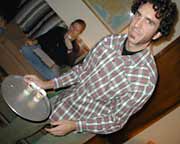Round Two
The excitement created by the successful conclusion of our first experiment brought six taste-testers back together on February 11, 2001 to sample seven new root beers. Well, actually six, since I secretly added one root beer from the Round One list in order to try to provide some coordinating points to the scores from each round.
With a new and improved score sheet and a more manageable root beer sample set, everyone was excited and thirsty to get started with the testing. But first, two taste-testers had not arrived! Finally, after an hour of waiting, the two errant researchers made their entrance, bearing materials for open-faced sandwiches, which we hastily devoured.
After a few other details were attended to, everyone sat down in the living room to commence the test.
The Root Beers Tasted:
The Test
For the second experiment, we came up with a different method to prepare and hide the identities of the root beers. Each bottle or can was wrapped in newspaper to hide the label (see photo below) with masking tape to hide the labels on the caps. All the bottles were kept chilled in the fridge right up the moment that particular round of samples was poured. Hidden from view in the kitchen, one of the researchers, who had not seen the bottles in the experiment beforehand, chose each round randomly from the wrapped bottles and cans in the fridge. Then he labelled the chosen sample with a marker.
The taste-testers were given worksheets to rate the root beers from 1-5 in the categories of Sweetness, Creaminess, Complexity, Punch, Aroma, and Overall Taste, with space for additional comments and a long-shot space to guess the brand of root beer (which Jeanne won this time, with a correct identification of the IBC sample).
Perhaps the long wait before the test heightened the anxiety and salivation, or hunger and thirst from the dry atmosphere, or the refinements to the test methods improved the preservation of the integrity of the samples. In any case, several of the testers remarked that this test was much more intense and flavorful than Round One had been. Spirits were high as we sipped and pondered our way through each of the seven root beers.
When all samples had been tested all the bottles were brought in from the kitchen and unwrapped one by one.



Round Two Results
Round Two proved to be far more contentious than Round One. There was no general agreement on best or worst flavors as there had been in the first round. The same root beer declared by one judge to be the best was immediately argued to be the worst by the next judge. In the midst of this disagreement, the middle-of-the-road root beers stepped in to take the lead with un-controversial generic tastes. This seems to be the same strategy employed by most major brands of soft drinks. Too many unique or unusual flavors will undoubtedly win as many enemies as fans.
Once again, the tabulation of scores reveals a winner which may or not reflect the vocalized responses of the testers:
Total Scores
Average scores across all categories:
Overall Taste
Comparing the one category of "Overall Taste," here are the averages:
Analysis
Once the scores from all the judges were tabulated, the ratings for the controversial flavors seem to have averaged themselves out to medium-low rankings, allowing the less-controversial root beers to come out on top.
However, all the root beer scored higher in Round Two than Round One. Dog-n-Suds won the Overall Taste category with a 3.8 in this round, while only scoring a 3 in Round One. Is this due to differences in the scoring patterns of different researchers involved in each round of testing, or perhaps improvements to our chill control method? Or is it due to the extraordinary situation of hunger and thirst which occurred due to the delayed start to Round Two testing?
Despite the discomfort and anxiety produced, the delayed start seemed to heighten the excitement and richness of the testing process. Each root beer sample seemed better than the last. The subtle flavors and rich creaminess of each were more pronounced. The anticipation at the start, and limiting the number of samples to seven, allowed all the researchers to retain their enthusiasm and alertness throughout the testing procedures. We have no doubt that the last samples in the test were given an equal chance to score as well as first samples, as opposed to the suspicions of taster fatigue which may have detracted from the scores of the last samples in Round One.
These heightened perceptions were agreed to make Round Two quite successful. Can the excitement and anxiety of waiting be artificially re-produced in the next round of testing? One drawback to fasting before the test is that the scores of the initial sample may be slightly exaggerated due to researcher excitement when finally being allowed to drink. The first satisfaction of thirst may exaggerate the scores in the Overall Flavor category for that initial sample. This may explain the higher standing of Dog-n-Suds (Sample A) in Round Two than Round One.
Our Rigorous Taste Testing
Try your own Root Beer Showdown at Home!
Root Beer Resources on the Web
